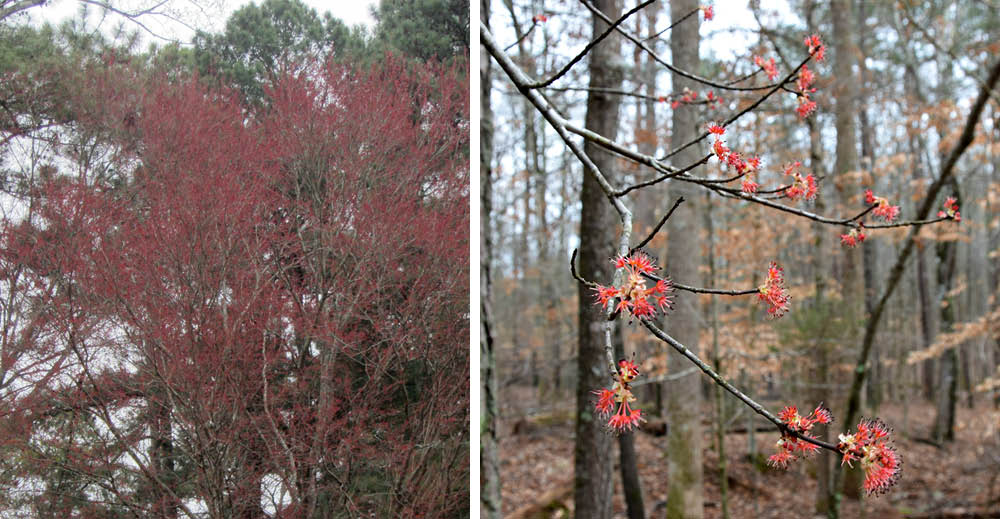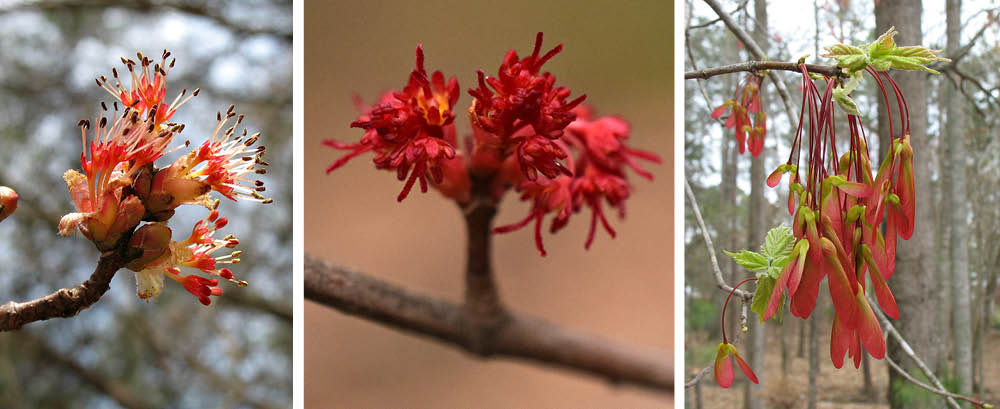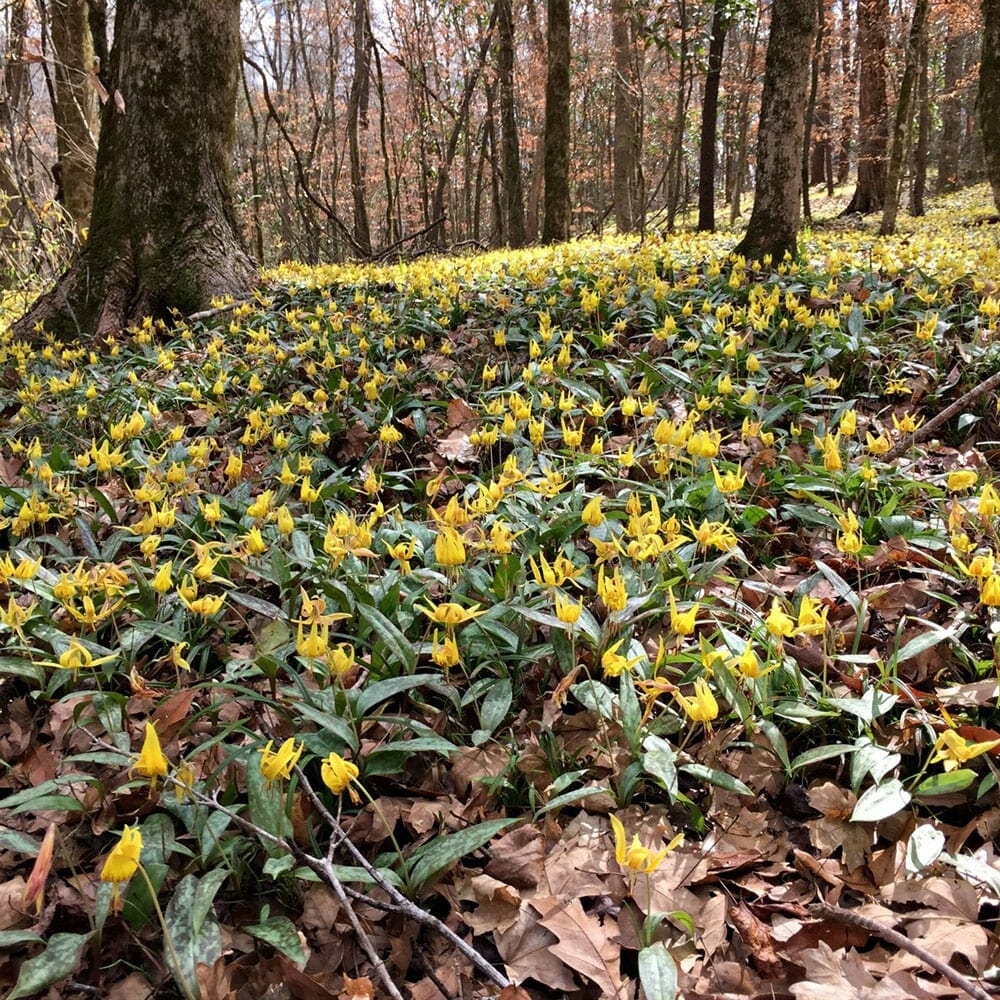
See the article in this issue about our symposium taking place this month!
In this issue ...
- Strategic plan
- 2022 Symposium
- Spotlight on red maple
- Mary-Scott Restoration Project is now an Audubon Wildlife Sanctuary
- How to help us advocate for native plants
Strategic Plan 2022-2025
 Connecting people with plants is one of the thrusts described in the Strategic Plan.
Thank you to those of you who have been on this transformative journey with us these last two years to create a state-led, chapter-focused organization. Welcome to those of you who have more recently joined. As we mentioned in the January newsletter, the State Board met in November to develop a three-year strategic plan aimed at increasing education, strengthening our partnerships and our chapters, and creating some advocacy initiatives. We promised to share the details with you and here they are.
We encourage you to read the whole strategic plan, but here are the highlights to help Georgians to grow a better landscape. Our goals are to:
- Make More of Us
- Conserve and Plant Better
- Leverage Partnerships
During our next three years, GNPS will accomplish our goals by focusing efforts in three main areas: Education, Conservation, and Advocacy. Our goals both focus and depend on member and chapter growth and support throughout the state. As you read these plans, think of how you might have the talents and the energy to join our efforts as an active volunteer.
High-level Education Plan:
- Create an educational pathway to actively encourage and increase the number of members knowledgeable about native plants.
- Create opportunities to educate traditional landscaping professionals, municipalities, and developers.
- Empower our chapters for success through leader training and other state-level support to grow the number of chapters and members served.
High-level Conservation Plan:
- Improve Georgia’s native plant habitat through a “Habitat Highway” program tied to our native plant habitat certification and site restoration programs.
- Expand the GNPS Plant Rescue program across Georgia via our chapters.
- Expand the GNPS Restoration Program across Georgia via our chapters.
High-level Advocacy Plan:
- Research, package and implement favorable plant policies for municipalities.
If you’d like to join the committee work dedicated to these efforts, please reach out to your chapter leadership or to the GNPS Board of Directors at strategic@gnps.org.
2022 Symposium
The GNPS 2022 Symposium is focused on Healing our Habitats, both at home and in designed landscapes, as well as conserving and restoring habitat in the wild. Through our actions and our designs, we have the ability to make a difference by getting more native plants into landscapes that have lost their connection with native ecosystems.
Using native plants in our gardens, our patios, our community gardens, our city/county parks, and in our business landscaping allows each of us to help heal the ecosystem and to support native insects and birds. No space is too small to make a difference and we make a bigger impact when we work together.
At the same time, conserving plants and their habitats in the wild is equally important. Learn more about how conservation support in Georgia works and how we can help.
All sessions qualify for CEU. In addition, the session with Rick Huffman and Tradd Cotter was specifically selected for landscape-professional interest.
Saturday, February 19th 9:00 am – 12 pm
-
Mincy Moffett – The Georgia Plant Conservation Alliance – a novel partnership that transformed plant conservation
-
Georgann Eubanks – Saving The Wild South: River Cane
-
Jennifer Ceska – Cues of Care in the Native Garden
Sunday, February 20th 2:00 pm
-
Angela Burrow – Why Garden Certification Matters
Sunday, February 20th 3:00-4:30 pm
-
Rick Huffman & Tradd Cotter – Applied Ecology: Approaches to Improving Landscapes and Ecosystem Health
The event will be virtual again this year. And like last year, it will be spread across two days, and each day’s sessions will be recorded for future playback. GNPS is partnering with Georgia Audubon to present this program. The cost for GNPS and Georgia Audubon members is $10 per day ($20 total across the two days); the cost for non-members is $12 per day. You can register here, but note that registration is being handled by Georgia Audubon. When you get to the registration site, you can dismiss the pop-up asking you to login in (if you are not also a Georgia Audubon member).
Plant Spotlight: Red Maple
Ellen Honeycutt
 Red maple (Acer rubrum) with flowers in spring.
I believe that red maple (Acer rubrum) is our earliest flowering tree. An oft-overlooked common tree, this native hardwood is found statewide in a variety of habitats. Much admired as a significant contributor to displays of fall color in the mountains, it is less appreciated for its early, but tiny, spring flowers. The bare twigs of maples slowly turn into a haze of red as first the buds swell, then the flowers open, and finally the winged seeds form.
Already I am seeing the flowers on trees in the metro Atlanta area, and I know they are already flowering in south Georgia. These early flowers are important nutrition for a variety of critters. When it comes to early bees, the native bees include mining bees, small sweat bees, mason bees, and cellophane bees. Male bees also use the trees as a place to look for females. Honey bees use the flowers as well.
Bird support is multi-faceted: some small birds will actually eat the flower buds and some of them eat the insects that are attracted to the flowers. Later, other birds will eat the seeds in the winged, double samaras. Later in the season, over 285 different types of moths (such as the Rosy Maple and Cecropia moths) can use the leaves as a host plant, further providing birds with insect food.
The male and female flowers are visually different. You can easily spot the male flowers by the presence of the pollen on the outstretched stamens. Often they are on different trees than the female flowers, but sometimes a tree will have male flowers on some branches and female flowers on others. Female flowers have two red stigmas with no pollen. Both flowers have very small petals surrounding the stamens and stigmas, so small as to not interfere with any wind-dispersal and collection of pollen (in addition to any insect pollination).
Red maple is good landscape choice throughout Georgia, providing significant ecosystem support as well as landscape beauty.

Red maple male flowers (left), female flowers (center) and seeds (right).
Advocacy
Carling Kirk
Many cities around the country have passed ordinances that encourage the use of native plants or prevent the use of invasive plants. Last year, the City of Roswell passed a resolution to plant more natives in city landscaping and many of our members contributed to that effort.
In our strategic planning in November, the board identified advocacy as a key element of our efforts in the next few years. As part of that plan, we are forming a committee to focus on researching pro-native plant policies for municipalities and we are looking for members to help! If you are interested in volunteering for this committee, send an email to advocacy@gnps.org.
Mary-Scott Nature Park is now an Audubon Wildlife Sanctuary
Susan Hanson
To be certified as an Audubon Wildlife Sanctuary, a site must offer habitat friendly to birds and wildlife, with few non-native invasive plants. These requirements are also consistent with the criteria and purpose of a GNPS Restoration Project.
Mary-Scott Nature Park is a GNPS Restoration Project in Dekalb County inside I-285. The 10.6-acre site has many large hardwood and pine trees with a variety of understory trees that benefit birds. Hardwood trees include American beech (Fagus grandifolia), white oak (Quercus alba), northern red oak (Quercus rubra), elm (Ulmus rubra), tulip poplar (Liriodendron tulipifera), mockernut hickory (Carya tomentosa). Understory trees include American holly (Ilex opaca), sassafras (Sassafras albidum), devil’s walking stick (Aralia spinosa), alternate-leaf dogwood (Cornus alternifolia), southern sugar maple (Acer floridanum), Carolina buckthorn (Frangula caroliniana), musclewood (Carpinus caroliniana), and red mulberry (Morus rubra). Unfortunately, the park has many non-native invasive plants, as well.
Some dedicated GNPS members and a few neighbors have been working in the park for six years. We have recruited some Cub Scouts, Boy Scouts, Girl Scouts and high school students who need service hours for National Honor Society and Beta Club. A neighborhood garden club and the local civic association have donated money. The main task has been removing English ivy and other non-native invasive plants. One workday, many GNPS members worked to remove two dumpsters of Asian bamboo. A county employee sprayed the stumps with glyphospate. It has required more spraying to kill the sprouts. With the money from the civic association, a commercial company was paid to remove non-native wisteria and bamboo.

Planted species at Mary-Scott incude mountain mint (Pycnanthemum incanum), left, and Virginia sweetspire (Itea virginica), center. The right photo shows some of the bamboo removed in a single workday.
The county had made a paved driveway at the front entrance of the park, creating a oval planting bed. There is a landscaping plan for this area that has been partially planted. A swamp white oak (Quercus bicolor) and Washington hawthorn (Crataegus phaenopyrum 'Winter King') had been planted in the area. We have added plants that provide food for birds and insects. We planted three shortleaf pines (Pinus echinata) and highbush blueberries that were included in the plan. We also planted beautyberry (Callicarpa americana), winterberry (Ilex verticilata), Virginia sweetspire (Itea virginica), Fothergilla (Fothergilla major), and viburnum (Viburnum obovatum 'Mrs. Schiller's delight'). In the same area we have planted some perennials: butterfly weed (Asclepias tuberosa), coreopsis (Coreopsis auriculata), goldenrod (Solidago rugosa ‘Fireworks’), ironweed (Vernonia gigantea), purple coneflower (Echinacea purpurea), blue-eyed grass (Sisyrinchium sp.), white wood aster (Aster divaricatus), stokesia (Stokesia laevis), mist flower (Conoclinium coelestinum), false indigo (Baptisia australis), Georgia aster (Symphyotrichum georgianum). We also planted mountain mint (Pycnanthemum incanum), which was the most visited flower at the summer pollinator count.
The main part of the park is heavily wooded and shady. We have planted many shade-loving plants in this area. At the back part of the park is a stream and damp soil where we have planted mayapples (Podophyllum peltatum), sedum (Sedum ternatum), and ferns that include Christmas (Polystichum acrostichoides), sensitive (Onoclea sensibilis), and netted chain (Lorinseria areolata).
These efforts have resulted in the official designation of the park as an Audubon Wildlife Sanctuary, But there is much more to be done to make it a true native plant habitat. Novice GNPS members could come to learn about the native plants we have labeled and help us remove the many non-native plants. Experienced GNPS members could help us plan how to add additional native plants and plant them.
Our regular monthly meeting day is the first Saturday of the month, in the afternoon during the cold months and in the morning during the hot summer months. If there is additional interest, a weekday workday could be added. Mary-Scott Nature Park, 4150 Briarcliff Road, is a lovely place now and our vision is to increase its beauty with more of the many native plants we have in the Piedmont of Georgia.
Chapter News
Augusta's River Region Chapter
Augusta's River Region Chapter will be hosting a training for Rescue Facilitators and encourages anyone in the Augusta region to reach out to the chapter if they are interested in attending. Members from other GNPS chapters can get in on this training as well! Contact us at augusta@gnps.org.
North Georgia Mountains Chapter
Our first meeting of 2022 will be on February 12th at 10 a.m. in room 107 of the Maxwell Center at Young Harris College. Our speaker will be Donna Shearer, on the topic of Saving Georgia’s Hemlocks. Members and guests are all welcome. In the brief meeting before the presentation we will be introducing our current plans for installing native plant gardens, the first to be at the historic train depot in Mineral Bluff.

Full bloom at the Wolf Creek Trout Lily Preserve.
Fringed Campion Chapter
The chapter is organizing a full day field trip with guided tours of Lost Creek Forest and Wolf Creek Trout Lily Preserve. The timing of this trip was chosen to allow viewing of the dimpled trout lily (Erythronium umbilicatum) during peak bloom. The Wolf Creek Trout Lily Preserve has the largest population known anywhere of this beautiful native. Go here for details.
West Georgia Chapter
West Georgia Chapter is excited that the Buffalo Creek Trail has been designated as an eBird “hotspot.” eBird is a massive database, managed by the Cornell Lab of Ornithology, that houses millions of observations contributed by birdwatchers all over the globe. Scientists use eBird data to determine (among other things) the range, population, and habitat use of a bird species. Hotspots allow multiple birders to contribute data about a shared location, making it possible over time to accumulate a wealth of information about that location’s bird life. The Buffalo Creek Trail encompasses a variety of bird habitats, making for a rich birding experience, and we invite everyone to come and enjoy it. When you submit your checklist to eBird, select the location “Buffalo Creek Trail, Carrollton,” and help us build our species list.
The chapter is pleased to announce the appearance of Mark Warren, naturalist, composer, novelist and director of Medicine Bow — a school teaching the primitive skills, crafts, foods, and medicines of the Cherokee in the north Georgia mountains.
Mark’s presentation, “Design in Nature” is best described in his own words:
Nature has a quiet, invisible force always pushing plants and animals toward success. We will have a look at both the botanical and animal sides of this, with our emphasis on native plants. What we see in our lifetime is the present version of each particular species’ state of succeeding, and it is worthwhile to remember two things about this phenomenon:
- What you see before you is necessarily a view of what has proved to be successful up to now.
- But the process is still ongoing. The force never sleeps.
We can study a common feature of any plant: a prickly spine, a cluster of tiny hairs, the shape of a leaf, a color from a botanical pigment, the length of a flower stalk, a scent, a tasty flavor, etc. These everyday details of plants can be looked at from an entirely new perspective, giving us even more respect for that plant’s design and purpose. These little architectural or functional points are speaking out to us, telling us of the struggle to survive and the brilliant solutions that nature has bestowed. This program will help lead the audience to know how to listen to the story that is as old as time.
The presentation is on Saturday, March 5 at 10 a.m. All of the details can be found on the event calendar.
Coastal Plain Chapter
Four new pollinator garden projects: The Coastal Plain Chapter has a role in the creation of four new native plant gardens in South Georgia.
- In Nashville, CPC members are helping the Berrien Middle School Wildlife Club with a new pollinator garden.
- In Waycross, CPC members are involved in new native plant landscaping at the Okefenokee Heritage Center.
- In Alapaha, CPC members are instrumental in the city’s new landscaping at the Alapaha Railroad Depot.
- In Albany, CPC members are working with the local Master Gardener group in bringing new life (and new plants) into the Chehaw Native Plant/Pollinator project.
Assistance varies by project, but includes advice on native plant selection, design assistance, and the provision of native plants propagated by the CPC.
Native plant education on the road in southwest Georgia: The Coastal Plain Chapter will have an educational booth and offer a short stage presentation on the benefits of native plants on March 5th, at the Whigham, Ga. Rattlesnake Roundup. We will be among other organizations providing conservation and environmental education, including the Department of Natural Resources, Quail Forever, and Southeastern Reptile Rescue. Note: Snakes may be on display for educational purposes, but they are not harmed.
New Partnership: A new partnership is underway with the Camellia Chapter of the Garden Club of Georgia, Inc. to revive the South Georgia Native Plant & Wildflower Symposium, organized for many years by the University of Georgia, Tifton Campus. With pandemic-related event cancellations and the retirement of two event coordinators, UGA Tifton decided to stop hosting the event. The Coastal Plain Chapter of GNPS and the Camellia District of GCG are now working together to present the event in Valdosta on March 30, 2022. For more information: https://gnps.org/chapters/sgnpws/ |